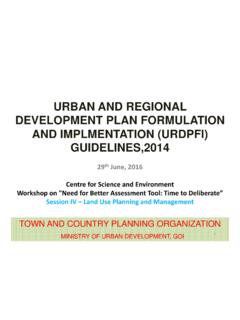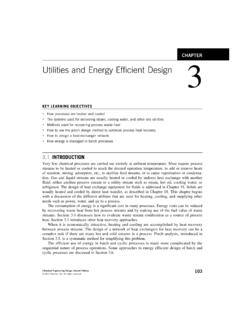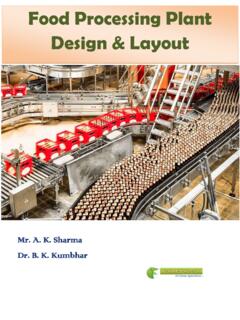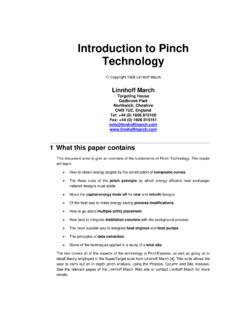Transcription of Urban Street Design and Development - Centre for Science ...
1 Ashok Bhattacharjee, Advisor, Clean Air and Sustainable Mobility, Centre for Science and Environment CSE Workshop on Safe Access and Parking - Lytton Hotel , Kolkata Urban Street Design and Development Urban Situation M ITO Cars & Rickshaws Encroachment on footpath Hawkers & Bus stops Public utilities 3 7/26/2012 UTTIPEC Need for coordinated infrastructure within road space Sample Image from Hyderabad . Foot over bridge- Failure due to longer walking Every 2nd death on road is of a pedestrian Facts.! About 15% of road users (cars) take up 80% of road space. Parking of personal vehicles: Inequity in Urban land use The overarching objective for parking is to progressively reduce the demand for parking and facilitate organized parking for all types of vehicles 1.
2 BIOSWALES HOW ?? Bio-swales Under utilized area under flyovers can be modified for bio-filtration Underground utility ducts NEED FOR STORMWATER MANAGEMENT !! PARKING PRICING AND ENFORCEMENT Parking pricing worldwide Indian cities Private vehicle Park on a fully-paid, rented or owned space, based on user pays principle 45% CAR USERS SHIFT TO PT IF PARKING PRICING IS INCREASED BY 500% Willingness to Pay survey by RITES On- Street parking shall not interfere carriageway. Shall be in defined lots. Street space is a scarce resource. On- Street parking shall not be allowed for more than 2 hours.
3 Short- term parking shall be made expensive. 2. Non-Signalised High Speed Corridors Increased fatality for pedestrians and cyclists Average Peak Hour Speed- 5-10Km/Hr Average Off-Peak Hour Speed- 80Km/Hr 1. Out of scale Infrastructure Safety of humans, cyclists at risk Impact and Challenges Mobility and Safety Negative impacts - air quality, road safety , energy use , affordability, universal accessibility ,traffic congestion and demand for precious Urban land for parking. Challenges of Urban mobility Preoccupation with mobility enhancement and infra-structure expansion rather than the realization of accessibility.
4 Strengthen and integrate various modes of transport which are energy efficient , environment friendly, safe and affordable to the people Walking, cycling, non motorised modes, IPT, public transport modes (Bus, Metro, trains) together act as a sustainable mobility system. Buses and IPT as fuel consuming and polluting modes need to opt for cleaner fuel or alternate energy source with governmental support on fiscal matters with system planning and infrastructure Design priorities Challenges of Urban Streets Uncontrolled growth of motor vehicles - main cause of increased congestion during peak hours and high fatal accidents during non peak hours.
5 Universal accessibility -most important safety aspects under inclusive planning approach. Complete neglect for majority of road users ie pedestrians (including disabled, children, women and elderly people) and cyclists due to widening of carriageway and construction of flyovers with misconceived notion of removing congestion on Urban streets. Highway specific Design approach -Neither congestion nor accidents have reduced in any Urban area by following. Segregation of traffic and controlling motorised traffic speed should tackle both congestion and safety on Urban streets. Adoption of specific Urban Street Design norms along with adoption of specified process of planning and Development of complete streets will ensure safe, smooth and regulated traffic movement.
6 Global experience indicates that Urban Street Design and Development - enhance the safety of vulnerable road users increase mass transit and NMT use leading to better air quality, low energy use and low congestion on roads benefitting large section of people with better quality of life 2. National Urban Transport Policy As per Indian National Transport Policy: The Central Government would, encourage measures that allocate road space on a more equitable basis, with people as its focus. THE PROBLEM Noise, Vibration and Air Pollution Traffic Speed Traffic accident Impact on Land Use and Social Stability Traffic volume and composition Reduction of Street Activities Appearance, Identity, and Maintenance Urban Road Network Close grid network for distribution of traffic over the network Urban Roads and Streets Safe streets and equitable distribution of road space Access Management inclusive and universal accessibility Intersections and Interchanges Pedestrian/NMT friendly Design of Streets Complete Street with provision of all road elements.
7 Street Design Process Preparation, Deliberation and Approval Stages Implementation and Management Construction, audit, maintenance and management Planning, Development , Management and Inspection of Urban roads and streets for - New Cities/towns as well as existing cities and towns ( Restructuring and retrofitting) Pedestrian/NMT friendly streets : Sustainable Street Design Road hierarchy: According to function of road rather than land-use. Reservation of road space -50% of available RoW is to be reserved for non-motorized uses, while 50% is to be reserved for carriage way. Priority to public transport: Bus lanes are to be provided in roads up to collector roads.
8 Transport Infrastructure - Vehicle oriented flyover and traffic interchanges are to be discouraged on all roads except expressways. Order of priority Complete Street concept Urban ROAD NETWORK Existing Challenges Macro level planning TOP DOWN APPROACH: Vehicle- oriented growth Urban Sprawl Less priority for neighbourhood Development , pedestrians, NMV or cyclists ! Loosing liveability of cities! BOTTOM UP APPROACH OF PLANNING Safe mobility for pedestrians, cyclists and NMV users Planning from neighbourhood level Pedestrian focused streets Liveable cities ! The chapter discusses different Urban road / Street network patterns with Network planning principles and strategies for both new as well as retrofitting developments.
9 Chapter Discussion Highlights Chapter Discussion Highlights Design OF STREETS Street Zoning and Functions The Pedestrian Zone Frontage Zone or Dead Zone Multi-Functional Zone (MFZ) Planting Zone Street Furniture Zone Street Design Elements All Design elements are not elaborated , but mandatory Street elements for different hierarchy of roads to make it active streets are provided in consolidated table Chapter Street Design PROCESS The approach of Street Design process is to make Urban streets ready for multi modal transportation networks that can safely accommodate access and travel for all users.
10 Vision statement Street Design Process Terms of Reference Stage I: Inception Report Stage II: Conceptual Design Options Stage- III: Detail Design of Approved Proposal Type of Surveys Topographic and Landscape surveys, Land-use surveys, Survey of pedestrian facilities, Pedestrian and cyclist movement surveys, Street vending and activity surveys, Parking surveys and Traffic surveys. Plans Depicting Existing Scenario Proposed Concept plans Street Design Review and Finalization Detailed Design Chapter Discussion Highlights IMPLEMENTATION OF Street Design Chapter Discussion Highlights MANAGEMENT OF Urban STREETS ROAD SAFETY AUDITS Relevance of doing audits.










